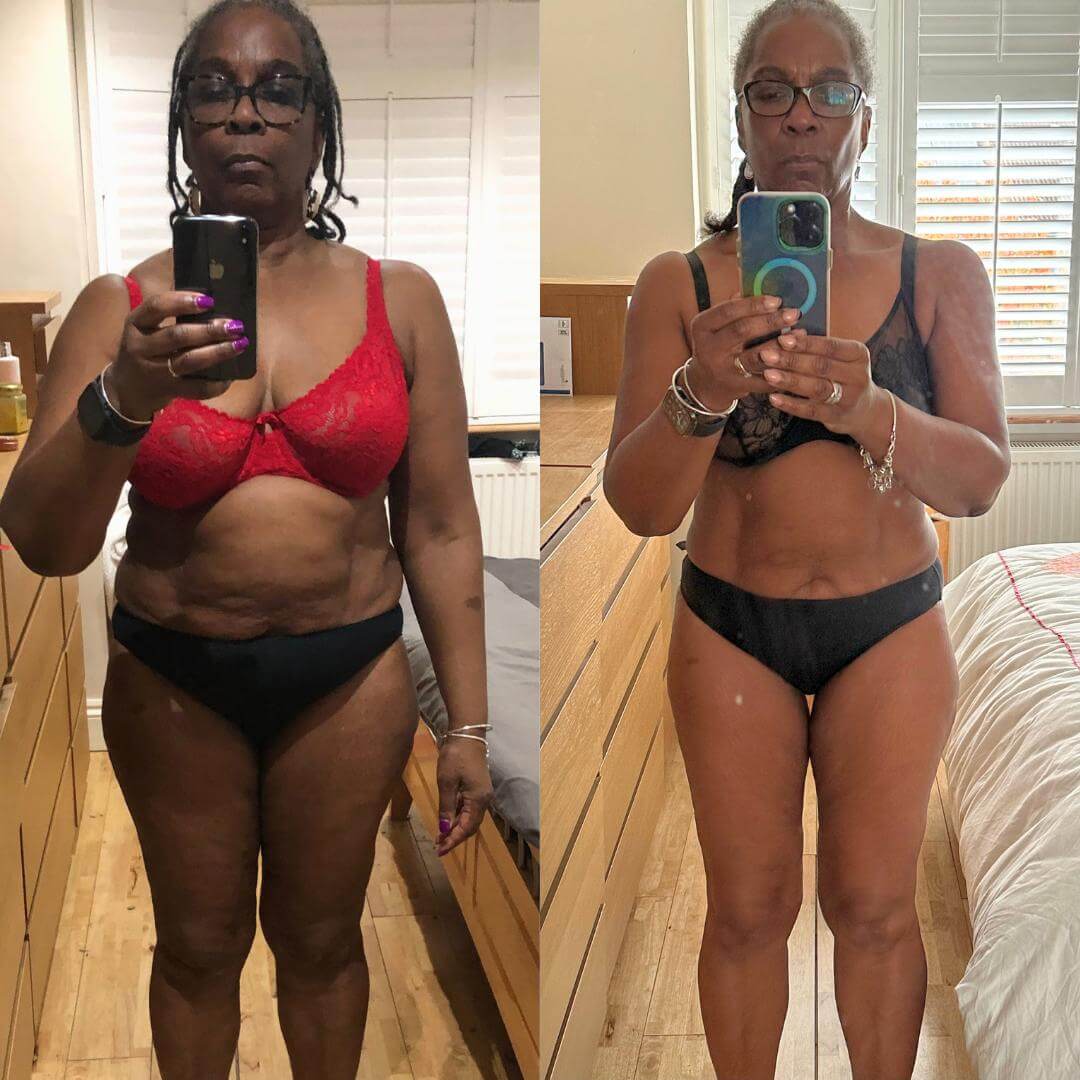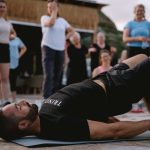If you’ve been wondering how to start strength training as a woman in your 40s, 50s or 60s, you’re not alone. Many of our clients at Trinity Transformation come to us feeling frustrated, usually because their body has changed, their usual workouts aren’t working, and no matter how “healthy” they eat, the weight just won’t budge.
Most of them have tried cardio, cutting carbs, or slimming clubs. Some have even looked into weight loss jabs or medications. But despite all the effort, the results haven’t come.
This is exactly why we focus on strength training as the foundation of our Fit Over 40 program. Because when done properly, strength training helps reverse the muscle loss caused by menopause, boosts metabolism, reshapes your body, and helps you lose 1–2 dress sizes in just 12 weeks.
We’ve now helped over 7,000 women through menopause with a 97% success rate, and strength training is a huge part of why they’ve seen such lasting results.
In this article, we’ll walk you through how to start strength training from home, what equipment you need, how many times per week is ideal, and why this approach works so well for menopausal women.

Why Strength Training Works
Strength training at least three times a week, using moderate to heavy weights and lower reps (between 5 and 15), is the gold standard. This style of training is particularly important post-menopause, when lower oestrogen means the body needs more stimulus to build and preserve muscle.
In fact, lifting heavier is more effective as oestrogen drops, because it gives the body a strong enough signal to maintain lean mass.
In our experience coaching over 7,000 women, we’ve found that a method called LIST (low-impact strength training) delivers the best results.
These are slow, controlled movements using heavier weights than most women think they need, done at home, just three times a week.
It’s simple, sustainable, and incredibly effective. Not only does it tone your body, reduce stubborn fat and lift areas like the stomach and bum, it also helps manage stress, improves joint health, and keeps cortisol levels in check, which is vital in menopause when stress can easily tip the scales and slow fat loss further.
How to Start Strength Training Over 40 From Home
If you’re just starting out, it can feel confusing or even a bit scary. What exercises should you do? What equipment do you need? How heavy should your weights be?
Here’s the simple setup that works best for our clients.
Space Requirements
You don’t need much.
Just enough space for a yoga mat (the size of you lying down), and room to stretch your arms out. Many of our clients train in their living rooms, kitchens, or even their gardens.
Equipment: What You Actually Need
To get results, you’ll need weights. Most women start with weights that are far too light, but this won’t trigger the change your body needs.
We recommend getting 3 kettlebells or dumbbells in each of the following weights: 4kg (10lbs), 8kg (15lbs) and 12kg (25lbs).
Use the heavier weights for lower body exercises like squats and lunges and use the lighter ones for upper body movements like shoulder presses or rows.
Bodyweight is usually too light to stimulate the lower body and too heavy to safely challenge the upper body for beginners. That’s why having a mix of weights is so important.
Sets, Reps & Rest: How to Structure Your Strength Training Routine
Once you’ve got the space and weights, here’s how to use them.
Reps and Sets
Reps = repetitions (how many times you do the movement).
Sets = blocks of repetitions (e.g. 3 sets of 10 squats).
The sweet spot for menopausal women is 3-5 sets of 5-15 reps per exercise and to aim for around 24 working sets per week. This is because lifting heavy with lower reps is better for maintaining muscle mass and reversing muscle loss caused by declining oestrogen.
Also ensure that you’re resting between your sets. For example, if you’re performing big movements like squats or deadlifts, aim to rest for 45-90 seconds between sets.
If you’re performing smaller exercises like bicep curls, you don’t need as long. 30-45 seconds would be enough rest time between each set.
Too little rest turns your workout into intensity interval training, which is cardio. That won’t build the muscle or bone health you need during menopause.

“Before Trinity I was 12 stone and unable to fit into most of my clothes except the size 16s. My knees started to hurt from the excess weight. Going up the stairs at home and work was making me out of breath. Since Trinity I’ve lost 11 kg and learnt so much about how important it is to look after my body through healthy eating and exercise. Knowing the importance of low impact strength training has been a game changer for me. I’m a completely different person, my body is now lifting weights that I didn’t think I could lift. I’m able to run and play more with my grandchildren and the learners at school. I was even able to challenge a student in my class to do some press ups!”
– Voland Johnson (64), Trinity Client
What If You’ve Never Done Strength Training Before?
That’s okay. Most of our clients haven’t either.
That’s why we created our FREE 7-day plan to help women just like you learn exactly how to start strength training over 40. It includes everything from the right exercises to how often to train with no guesswork.

What Exercises Should You Do During Menopause?
Strength training during menopause isn’t about jumping around or using tiny pink dumbbells. It’s about using your time and effort wisely to build muscle, boost bone density, and improve mobility, without needing to spend hours at the gym.
Below are six simple but powerful movements every woman over 40 should include in her weekly routine.
You can do these at home with just a few kettlebells or dumbbells and enough space for a yoga mat.
1. Goblet Squat
What it works: Legs, glutes, core, and back
Equipment needed: 8-12kg dumbbell or kettlebell (start heavier if possible)
How to do it:
- Hold a kettlebell or dumbbell close to your chest (like you’re holding a goblet).
- Stand with feet shoulder-width apart, toes slightly turned out.
- Lower your body by pushing your hips back and bending your knees.
- Keep your chest tall and heels flat on the floor.
- Stop when your thighs are parallel to the ground, then push back up to standing.
Tip: Keep the weight close to your body throughout to protect your lower back.
2. Romanian Deadlift (RDL)
What it works: Hamstrings, glutes, lower back, core
Equipment needed: Two dumbbells or a single kettlebell (start with 8–12kg)
How to do it:
- Stand tall holding a weight in each hand in front of your thighs.
- Soften your knees slightly and hinge at your hips (not your waist), pushing your bum backwards.
- Keep your back flat and chest open as the weights lower down the front of your legs.
- When you feel a stretch in your hamstrings, pause, then return to standing.
Tip: This isn’t a squat, you should hinge at your hips. Imagine trying to close a car boot with your bum!
3. Reverse Lunge
What it works: Glutes, quads, hamstrings, balance
Equipment needed: Bodyweight or 4–8kg dumbbells/kettlebells (held by sides or at shoulders)
How to do it:
- Stand tall, feet together, holding weights or just your bodyweight.
- Step one foot back and lower your back knee towards the floor.
- Keep your front knee above your ankle (don’t let it push too far forward).
- Push through your front foot to return to standing.
Tip: Don’t rush. Focus on balance and control.
4. Bent-Over Row
What it works: Upper back, lats, biceps, core
Equipment needed: Two dumbbells (start with 4–8kg)
How to do it:
- Hold a dumbbell in each hand, hinge at the hips and slightly bend your knees.
- Keep your back flat and chest open.
- Pull the weights up towards your ribs, squeezing your shoulder blades together.
- Lower with control.
Tip: Don’t let your shoulders round forward. Think “elbows to the ceiling”.

“Before I started Trinity I was pretty fed up, my weight had gradually crept up to nearly 80kg. I felt I was relatively fit- an active member of 2 gyms doing regular classes like body attack, body pump, HITT step, balance, yoga/ Pilates, going at 6.45am and often after work too. The more I tried to concentrate myself to lose some weight, the more I would find myself thinking about food. In just over a year with Trinity, weight wise I have lost 13kg and now I enjoy my LIST workouts, it’s part of my routine, I canceled my gym memberships and have gone from 2 workouts a day to just 3-4 workouts a week. My strength and mindset has totally changed. I feel much happier, and satisfied with life.
– Helen Huntington (57), Trinity Client
5. Overhead Shoulder Press
What it works: Shoulders, arms, upper back
Equipment needed: Two dumbbells or kettlebells (start with 4–6kg)
How to do it:
- Hold weights at shoulder height with elbows bent.
- Press the weights overhead until your arms are straight but not locked.
- Lower them slowly back to shoulder height.
Tip: Keep your core tight and don’t arch your lower back.
6. Glute Bridge
What it works: Glutes, hamstrings, core
Equipment needed: Bodyweight or place a weight on your hips (start with 8–12kg)
How to do it:
- Lie on your back with knees bent, feet flat on the floor.
- Push through your heels to lift your hips as high as you can.
- Squeeze your glutes at the top, then lower slowly.
Tip: Keep your ribs tucked and don’t push too far into your lower back.
Don’t Forget Your Protein
If your goal is to lose weight and tone up, strength training alone isn’t enough. Protein also becomes more important with age.
A 2018 study found that after eating, older women had a much smaller increase in muscle protein synthesis compared to younger women. This could sometimes be up to 40% less.
That means the same meal that might build and repair muscle in a 25-year-old won’t be enough for a woman in her 40s or 50s.
To make up for this, older women need more protein to see the same benefits from their training.
For example, if a 70kg woman in her late 40s wants to get the same training response as someone in her 20s, she’ll need around 28g of protein post-workout.
The younger woman would only need around 17g. During perimenopause, aiming for around 1.2 to 1.6 grams of protein per kg of body weight per day helps maintain muscle.
Post-menopause, this should increase to 1.6 to 2 grams per kg to support recovery, strength, and fat loss.
Watch How To Start Strength Training Over 40 Here
How Trinity Can Help You Get Started
Our approach works because it’s built around your body’s needs at this stage of life. We don’t hand out one-size-fits-all plans or generic advice. Everything is tailored to you, from your training, to your nutrition, to the way we support you.
You’ll be guided by expert coaches who know exactly how menopause affects your hormones, your metabolism and your energy levels and how to work with your body to get results.
That means:
- Low Impact Strength Training (LIST) to rebuild muscle and boost metabolism
- Nutrition tailored to your hormones (so you lose fat without cutting carbs or starving)
- Step-by-step coaching so you always know what to do and why
- Accountability and support from expert coaches who specialise in helping menopausal women
- A flexible routine that fits into your busy life—even with work, family, and everything else on your plate
This is a complete re-education in how to take care of yourself as your body changes so you can feel stronger, more confident, and back in control of your weight and health for good.
Frequently Asked Questions
I’ve never lifted weights before, can I still start strength training in my 40s or 50s?
Absolutely. Most of our clients are complete beginners. With proper guidance and the right approach, you can safely build strength, boost energy and reshape your body at any age.
What equipment do I need to start strength training at home?
You’ll need just a few kettlebells or dumbbells. We usually recommend 4kg, 8kg and 12kg to start. Aim for heavier weights for lower body movements and lighter for upper body exercises.
How many days a week should I do strength training?
For beginners, three sessions per week is ideal. This gives your body enough time to recover while still building momentum and results.
Will strength training help with menopause symptoms like belly fat and low energy?
Yes. Strength training helps reduce belly fat, improve muscle mass, stabilise blood sugar and support overall hormonal health, all of which help reduce common menopause symptoms.
How long until I see results?
Most women in our program see visible results within the first 4–6 weeks and drop 1–2 dress sizes (15–25lbs) in 12 weeks when following our full coaching system.




